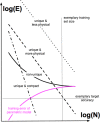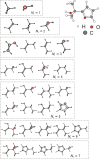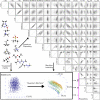Ab Initio Machine Learning in Chemical Compound Space
- PMID: 34387476
- PMCID: PMC8391942
- DOI: 10.1021/acs.chemrev.0c01303
Ab Initio Machine Learning in Chemical Compound Space
Abstract
Chemical compound space (CCS), the set of all theoretically conceivable combinations of chemical elements and (meta-)stable geometries that make up matter, is colossal. The first-principles based virtual sampling of this space, for example, in search of novel molecules or materials which exhibit desirable properties, is therefore prohibitive for all but the smallest subsets and simplest properties. We review studies aimed at tackling this challenge using modern machine learning techniques based on (i) synthetic data, typically generated using quantum mechanics based methods, and (ii) model architectures inspired by quantum mechanics. Such Quantum mechanics based Machine Learning (QML) approaches combine the numerical efficiency of statistical surrogate models with an ab initio view on matter. They rigorously reflect the underlying physics in order to reach universality and transferability across CCS. While state-of-the-art approximations to quantum problems impose severe computational bottlenecks, recent QML based developments indicate the possibility of substantial acceleration without sacrificing the predictive power of quantum mechanics.
Conflict of interest statement
The authors declare no competing financial interest.
Figures






References
-
- Rupp M. Special issue on machine learning and quantum mechanics. Int. J. Quantum Chem. 2015, 115, 1003–1004. 10.1002/qua.24955. - DOI
Publication types
MeSH terms
Substances
LinkOut - more resources
Full Text Sources

